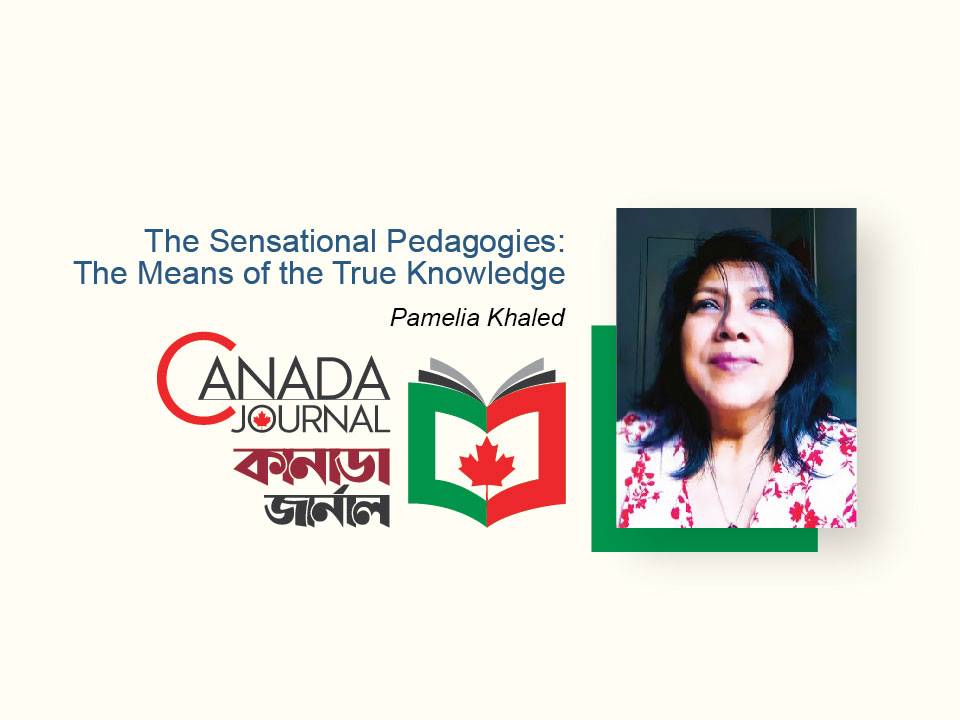The Sensational Pedagogies: The Means of the True Knowledge
My interest in sensational pedagogy in Bangladesh is twofold. First, I would like to explore if the five senses are used in the pedagogy in some way, as innate and natural form of learning method. Second, I want to make room for thinking about sensational pedagogy in a holistic and integrated manner in the Bangladesh context. During my childhood I was taught by my both parents through sensational pedagogies to learn about the objects, environments, nature and social and cultural issues using mother tongue, Bengali language and the two other second languages English and Arabic. Over the period I learned more about the importance of sensational pedagogies and observed how learners could use the five senses in their learning and explore whether they use them consciously. I then realised that something must be wrong with the mainstream’s transmission mode of teaching and I started about researching how children could be better taught.
Pinar and Grumet (1976) consider that curriculum is an autobiographical text and posit narrative as a theoretical basis for curriculum development (Weenie, 2008, p. 549). As educators, then, it is essential to recognize the essence of key moments in our past and present experience, followed by a progressive analysis of the future. Indeed, it is in this spirit that I incorporate here the sensational pedagogy approach, which is drawn on my own educational experiences in Bangladesh.
In our childhood we were taught by my father largely which was sensorial learning, a holistic education similar to Dr Maria Montessori’s teaching method: The senses (sight, touch, hearing, taste and smell), are developed individually through the handling and use of appropriate equipment.
Our home education is driven by my father with an ambitious aim. His idea was to aid his children’s development into a ‘whole’, a human being, who understand her/himself, with her/ his surroundings, environment, and culture of society and with humanity as a whole. As we find the traditional approach to education remains focused on the transmission of prescribed knowledge. On the other hand, my father’s approach was focused on providing support to his children’s natural development using sensorial learning, the five senses, the means of true knowledge, which turns sensation into perception. His understanding about holistic education was to develop not only intelligent mind rather fully developed human being so she/he become an integrated and contributing member of society. Main focus was to provide true knowledge: the development of children’s character as a whole human being and integration of the whole personality.
In 1907 Dr. Montessori started working as the director of a nursery for 50 three- to six-year olds in a slum area of Rome. She allowed the children to work independently and to choose the activities that interested them most. And she developed the Montessori Method based on careful observation of what children revealed about their developmental needs.
Similarly, Springgay (2012, p. 255) proposes “a sensational pedagogy that would enable educators to reconceptualize teaching and learning as embodied, effective, and as a co-ontological experience.” She suggests that informal education starts with creative forms such as art and oral recitation, major events and crises, and sensational pedagogies – smell, taste and sound. “For example, if we smell something, it registers in our body as intensity—affect—and then as sensation. When this sensation crosses over into perception, we then organize the smell according to memories, past experiences with a similar smell, or associations we have with the scent” (Springgay, 2012,p.1). Sensational pedagogies keep us moving, inciting us to sense beyond this moment towards another moment.
According to Ramana (1995, p.37), Dignaga’s Pramanasamuccaya (“Compendium of the Means of True Knowledge”) is one of the greatest works on Buddhist logic. Dignaga, a fifth-century logician, “gave a new definition of ‘perception’: a knowledge that is free from all conceptual constructions, including name and class concepts. In effect, he regarded only the pure sensation as perception.” Furthermore, “Perception is thus the activity of structuring the contents of primitive sentience — from the physical and biological levels as traced elsewhere — and at every stage, from the most elementary to the most complex, it is always the comprehension of a whole” (Malik, 1995, p.44). The assumption is that learning takes place in the feeling, sentient, and moving body. There is a deep connection between learning process and the relationship between of sensation and pedagogy. Learning takes place as a potential in the transitional space between sensation and perception.
I believe in the primary years, holistic education can emphasize the connection with the earth through gardening and farming programs, science and math outdoor curriculums, guided nature walks to local conservation areas and other activities as a part of an environmental and community-building program. Whole child learning is linked to the concept of interdependence, and connections with nature help children to develop critical awareness and action for social change. Miller thinks that earth connections can rekindle children to the natural processes of life. For example, the wind, the sun, the trees, and grass can help children be alive and awaken them (2010 p. 68). Along the same lines, sensational pedagogy approaches can guide learners to learn with nature, and parents’ and teachers’ involvement can complement one another. Using sensational pedagogy approaches and the model of holistic pedagogy framework (transmission, transaction and transformation pedagogy), poor, rural primary-school children can be nurtured as whole children.
